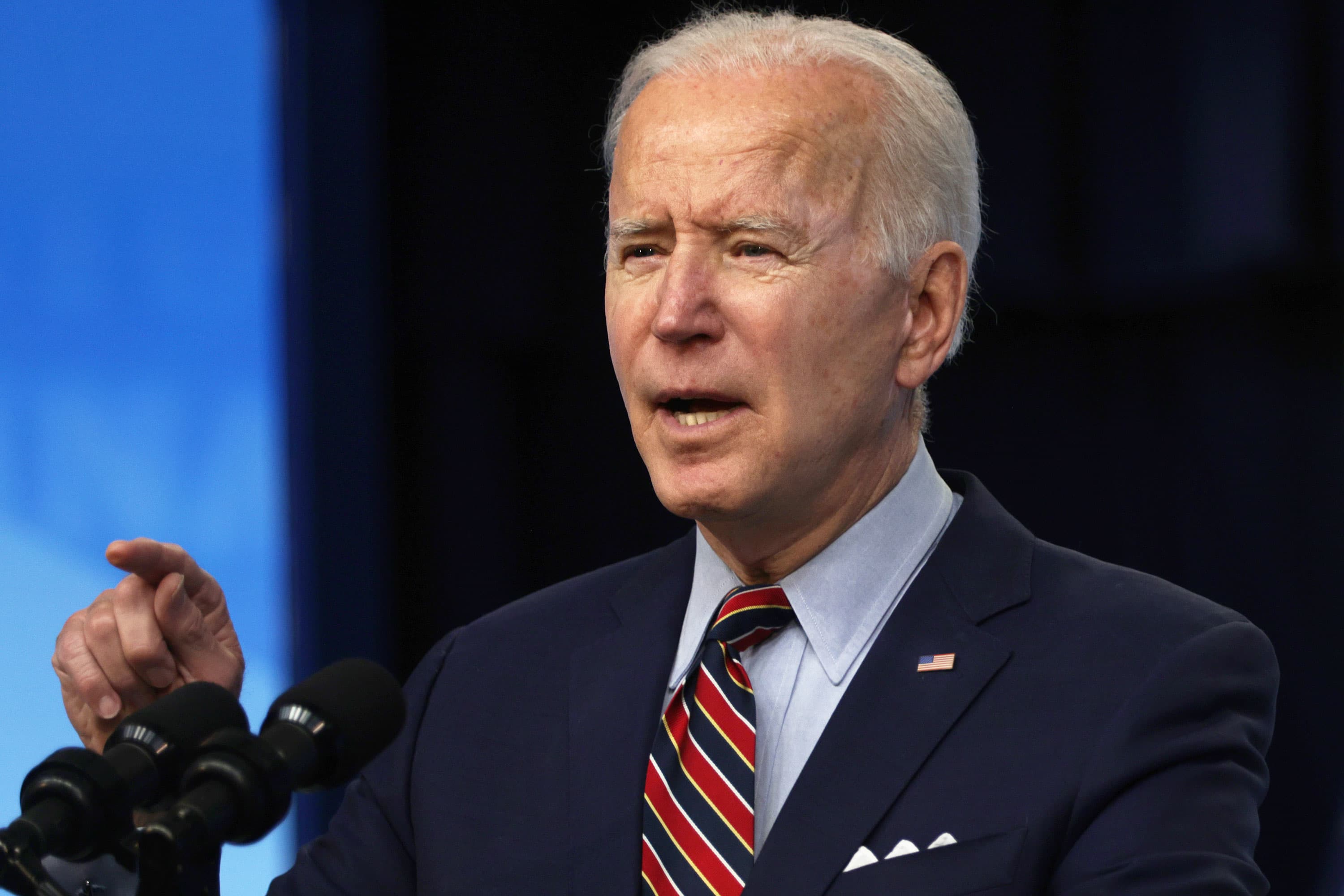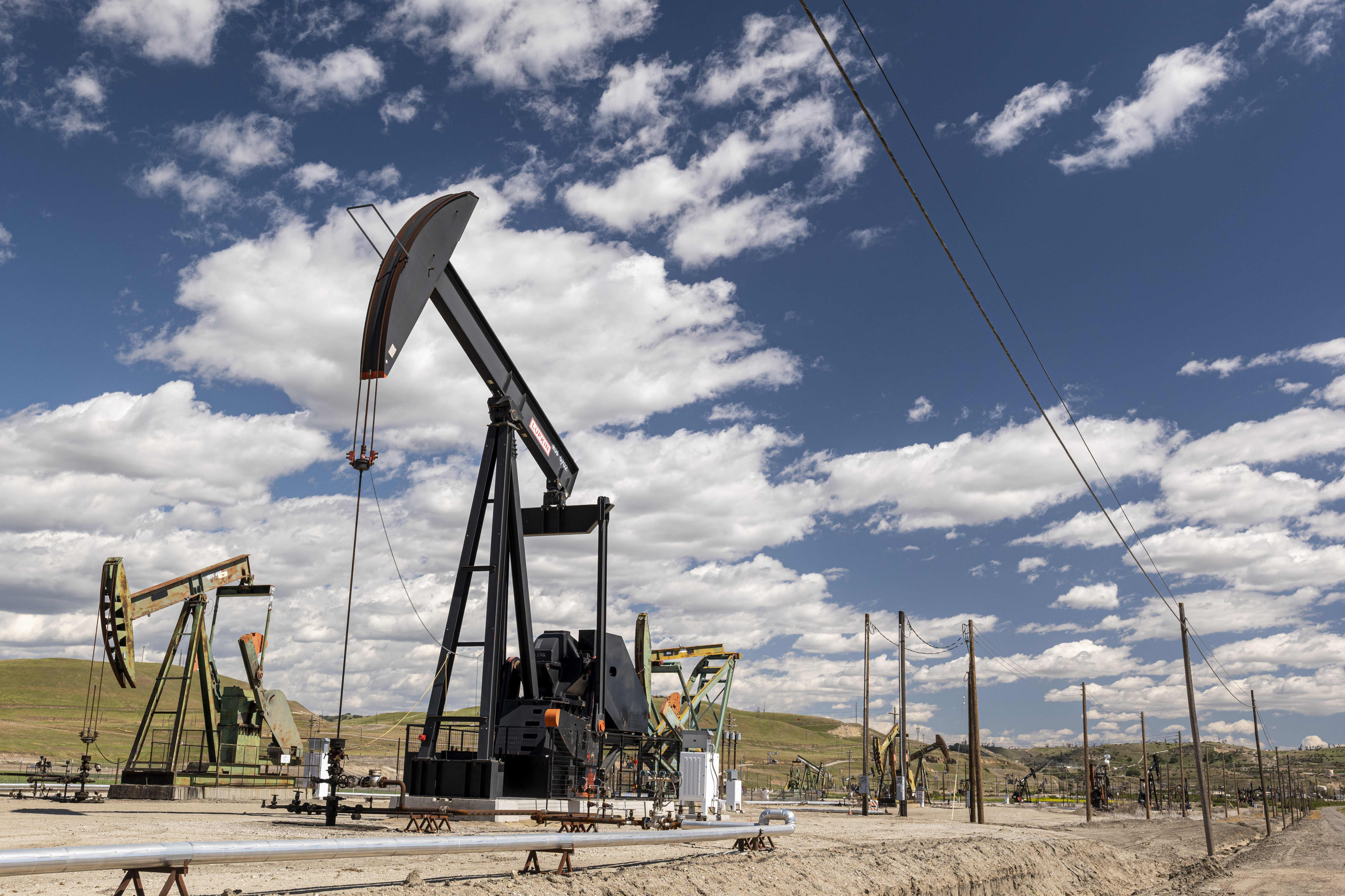In U.S. trade war with China, Mexico is emerging as the big winner
A CNBC analysis of trade data reveals a multi-year surge in trade between China and Mexico helping manufacturers and the supply chain avoid Trump/Biden tariffs.

A freight train carries cargo shipping containers in the El Paso Sector along the US-Mexico border between New Mexico and Chihuahua state on December 9, 2021 in Sunland Park, New Mexico.
Patrick T. Fallon | AFP | Getty Images
New data shows a surge in trade between China and Mexico at a time of tough tariff talk during the presidential campaign. Customs data shows a significant increase in raw materials and components from China entering Mexico to be manufactured into fully assembled items that are then transported into the U.S. via rail or by truck.
"We are seeing more Chinese companies moving their production facilities from China to Mexico," said Jordan Dewart, president of cross-border logistics specialist Redwood Mexico, adding that these facilities use Chinese third-party logistics companies, which provide services such as warehousing, inventory management, and shipping. "They can bring in their parts and raw materials from China and then produce the product in Mexico at their Chinese facilities and then ship those goods into the U.S. They are adding some value by operating in Mexico and taking advantage of the USMCA [United States-Mexico-Canada Agreement] to have their product made in Mexico."
This nearshoring of manufacturing enables companies to change a product's origin of goods, also referred to as the "economic nationality" of a product. When components or raw materials are imported into a country and used to complete a product, they undergo what trade officials call a "substantial transformation" and the manufacturing location determines the duties and other charges that can be levied on that product. Companies importing Chinese components and raw materials into Mexico and manufacturing their products in Mexico would have a "Made in Mexico" stamp on them, not "Made in China."
"The key sectors have always been automobiles and textiles in terms of determining origin," said Mary Lovely, Anthony Solomon senior fellow at the Peterson Institute for International Economics. "To have a product that's labeled Mexican as opposed to Chinese in origin, you have to substantially transform the product, which means it has to become a different product. So if I get a whole set of wooden boards, and it is manufactured into a desk. The product has to change customs categories."
The manufacturing shift has also changed the way European companies are operating across a wide range of products. "We have European-based companies who once solely manufactured in China and are now manufacturing their products here," said Simon Cohen, founder and CEO of Henco Logistics. The strong pace of nearshoring demand, with items being manufactured, boxed up, and shipped to the U.S. from Mexico, is being driven by the "China Plus One" strategy and the USMCA, he said.
Data from freight analytics firm Xeneta shows China to Mexico container trade up by 26.2% from January to July 2024, after growing by 33% in 2023. The month of May, in particular, recorded the most containers from China into Mexico, with June only a couple of hundred containers shy of May volume.
VesselBot, which also tracks container flows shows, says the three-month period of April, May, and June recorded the highest volumes of Mexico exports to the U.S this year.
Growth in demand for containers shipping imports from China into Mexico in the first half of 2024 is further fueling suspicions it has become a "back door into the U.S.," said Peter Sand, chief analyst for ocean freight rate benchmarking and intelligence platform Xeneta. "This route has grown increasingly popular over the past year-and-a-half," he said.
Mexico's free trade agreements and economic alliances make the country an attractive location for setting up manufacturing operations. Mexico has 13 free trade agreements spanning 50 countries, including the USMCA, and free trade agreements with the European Union, the European Free Trade Area, Japan, Israel, 10 countries in Latin America, and the 11-country Trans-Pacific Partnership. Mexico is also a member of the Pacific Alliance, a trade bloc formed by Mexico, Chile, Colombia, and Peru.
The surge in trade and manufacturing between the top geopolitical and economic rival to the U.S. and its southern neighbor comes amid continued political headwinds, with new tariffs on China and a potential crackdown on Mexican manufacturing both key campaign issues for former President Donald Trump.
"President Trump accelerated the shift in USA-China trade relations," said John Piatek vice president of consulting at procurement and supply chain consulting, services, and software solutions company, GEP Worldwide. "He continues to make China to be the bogeyman and has indicated he will get more aggressive."
But President Biden has retained most of Trump's trade protections, and his administration has also been aggressive in "propping up U.S. industries," such as semiconductors, Piatek said, as well as introducing new trade barriers to EV technology, among other areas, including medical supplies.
Piatek said the data shows imports from Mexico to the U.S. have increased 20 percent-plus annually between 2020 to mid-2024, in contrast to the trend of China to U.S. trade. Imports directly from China to the U.S. decreased from 17.7% to 13.5% from 2020 to mid-2024.
On the campaign trail, "Both candidates are speaking about introducing more trade barriers, not fewer," Piatek said.
Lovely said additional tariffs come with negative consequences. "The more tariffs we make, and the more sense of havoc we create, the more incentive that a black market springs up around it, as well as corruption with officials in developing countries," Lovely said.
The U.S. government is going after potential violations of trade policy. If a product is changed very little and it is shipped to the United States, it could be found in violation of U.S. countervailing duties and anti-dumping duties, Lovely said, citing recent cases related to solar panels.
The import surge aligns with a rise in cross-border trucking from Mexico to the U.S., particularly through Laredo, Texas. Data from Motive, which tracks trucking visits to North American distribution facilities for the top five retailers, shows a record level of truck border crossings and ground import volumes, cementing Mexico as the No. 1 U.S. importer amid declining Chinese imports. The top three U.S. destinations for Mexico exports are El Paso, Houston and San Diego.
A recent report on nearshoring by Moody's identified a number of announcements by auto companies, including foreign OEMs, regarding plans to invest in Mexico. "The automotive sector is a key player in expressions of interest to expand in Mexico by companies such as Tesla, BMW, Ford and GM, along with Asian manufacturers including BYD and Kia," Moody's noted.
Mexico's government reported $36 billion of foreign direct investment in 2023, a 27% increase over the previous year. In 2024, through mid-year, that figure was $31 billion, a new record, according to the government.
Trump has threatened to impose a 100% tariff on vehicles made in Mexico. During the recent presidential debate, he renewed claims he has made in the past about Mexican manufacturing linked to China. "They're building big auto plants in Mexico, in many cases owned by China. ... They're building these massive plants, and they think they're going to sell their cars into the United States because of these people [Biden administration]," Trump said.
Tesla CEO Elon Musk announced a pause on Tesla's gigafactory in Monterrey, Mexico. In the company's financial update for the first half of the year, Musk said uncertainty surrounding the tariffs would make it impractical to invest heavily in the plant. Tesla said it will ramp up production at its existing plants in Fremont, California, and Austin, Texas.
In a September statement, the Americas affiliate of Chinese electric car giant BYD denied reports it was pausing plans for a Mexican plant, identifying it as a "very relevant market."
Volvo, which is majority-owned by Chinese parent company Gheely, announced last month plans for a $700 million truck manufacturing plant in Monterrey.
Mexico has become critical to 'safeguarding' supply chains
Evading tariffs is not the only reason for the rise of Mexico as a trade conduit for China, as logistics professionals are increasingly using the Mexican route to "safeguard their supply chain," Sand said.
"Mexico is very much in focus for American importers seeking to handle the risks they face from higher tariffs and the U.S. East and Gulf coast labor dispute that threatens strikes to hit on October 1," he said.
Based on the bills of lading, the digital receipts of ocean freight containers, among top companies exporting from Mexico into the U.S. are Tesla, tire companies Pirelli and Michelin North America, Hyundai and Kia affiliate Mobis Parts America, and industrials firm SFK USA.
Charles Van der Steene, president of Maersk North America, said it has seen incredible growth in Mexico to U.S. trade this year.
"We're talking (growth) in general double digits," said Van der Steene. "The growth in Mexico is real. Some impact might be linked to tariffs, but overall, and by and large, we see the robust development of the Mexican economy."

In March, Maersk announced its new Tijuana, Mexico, facility that would optimize the growing volume of cross-border trade. The new warehouse is targeting the transport of items in the technology, automotive, retail, and lifestyle sectors. The company announced in September the opening of a 402,000-square-foot facility in El Paso, Texas, to support the growing logistics services demand at the border.
According to Moody's, in the last three decades, the value of Mexican exports has increased by more than tenfold. "Mexico's trade balance with the U.S. has improved significantly, from a deficit of $2.4 billion in 1993 to a stratospheric surplus of $234.7 billion in 2023," it reported.
Moody's also noted U.S. direct investment and reinvestments pouring into Mexico multiplied from $3.5 billion in 1993 to $20 billion in 2023.
Data from the Bureau of Transportation Statistics' TransBorder Freight program — which breaks down North American freight by mode of transportation, commodity type, and geographic detail for U.S. exports to and imports from Canada and Mexico — also shows the strength of Mexico/U.S. transborder trade.
The top ten commodities from Mexico exported to the United States include vehicles, computer-related machinery equipment, and parts.
Mexico freight trade route can be cheaper
Companies using the China-Mexico-U.S trade route are able to achieve lower freight costs when the avoided tariffs are factored into the equation, according to a CNBC breakdown of the costs utilizing August freight rates from various logistics providers. That's despite stronger pricing on the route due to its recent popularity.
Once ocean containers are on land, U.S. shippers can decide to move the containers by truck or rail into the United States tariff-free.
The overall cost of moving a single container is estimated at between $10,100-$12,300 for ocean freight/truck and $8,700-$8,800 by ocean freight/rail. This is slightly less expensive than sending a completed product from China to the U.S. directly, which is subjected to tariffs.
According to Redwood Mexico, the price for roundtrip trucking from the Pacific Coast Port of Lazaro, Mexico, to Laredo, Texas, for a single container ranges between $3,900-$6,100. The approximate cost to rail a single container from the Port of Lazaro to Laredo is $2,700. Transporting a container by rail from the Port of Lazaro, to Monterrey, California, would be around $2,600.
According to Freightos, the price of ocean freight from China to the U.S. West Coast is $6,459.20, while China to the U.S. East Coast is $9,480.20, and China to the Gulf Coast is $9,475.
ITS Logistics tells CNBC that the approximate all-in freight cost for an East Coast container is between $11,530.20-$14,745.20 by truck, and $11,030.20 for rail. The price of a container imported into the West Coast is between $10,959.20-$13,659.20 by truck, and $10,160.20 for rail.
If Chinese imports were subjected to the 301 tariffs, 232 tariffs, 373 (patent infringement), anti-dumping, and countervailing duties, the additional tariffs would be added to the cost of importing the product.
A 20-foot container of household washing machines holding roughly 50-60 washing machines, which are subject to a 7.5% tariff if imported from China, are one example of the tariffs' added economic bite to the logistics bill.
"At the average import price of $400 a unit, a U.S. importer would owe somewhere between $1,500 and $1,800 in trade war taxes on a 20-foot container of washing machines," said Erica York, senior economist at the Tax Foundation. "Bilateral tariffs should be expected to lead to trade diversion, and that's exactly what happened in the aftermath of the trade war. Not only did the tariffs lead to higher costs for Americans, but they also led to disruptions and reallocations of trade flows and business relationships," York said.
"The shift toward nearshoring has highlighted the cost benefits of ocean freight from Asia to Mexico, with average rates around $4,200 per container and trucking from Mexico City to the U.S. averaging $4,000," said Tim Robertson, CEO of DHL Global Forwarding America, though he added that logistics decisions should not be based solely on cost, with transit time, reliability, security, and service levels equally important to rates.
Election threats, new USMCA trade deal scrutiny
Ian Arroyo, chief strategy officer of Freightos, said the increase in Chinese goods flowing into Mexico is largely being driven by a combination of geopolitical factors, supply chain reconfigurations, economic strategies, and market opportunities that began during the pandemic.
"It's obvious at this point that due to these supply chain disruptions not only are foreign non-domestic companies using Mexico to build in a net reduction of cost, but American companies as well," said Arroyo. "The question is will the next administration take a hard look at the USMCA exemption to move Asian goods through Mexico?"
When the Trump administration renegotiated NAFTA into the USMCA in 2020, one key provision was a requirement for the countries to begin reviewing the trade deal after six years, a process that will begin in July 2026. If one or more of the three parties decides to not renew the agreement, there will be no immediate end to the deal, but it will trigger years of uncertainty for the markets about the ultimate fate of the trade route.
US President Donald Trump arrives to speak about the United States - Mexico - Canada agreement, known as USMCA, during a visit to Dana Incorporated, an auto supplier manufacturer, in Warren, Michigan, January 30, 2020.
Saul Loeb | Afp | Getty Images
"I am afraid that Mexico is getting a bad rap because 301 duties can be avoided in manufacturing in any country around the world. It does appear that China is finding Mexico to be a good platform, though, for their products (materials and parts). I would think that this will be a topic of discussion in the 6-year review," said Evelyn Suarez, founder of the Suarez Firm, which consults with corporations on customs and international trade law and policy.
If the nations are all in agreement to continue the deal, "We do not expect this flow to slow down," Arroyo said. "As global trade continues to evolve in an ever increasingly complex geopolitical environment, Mexico's role as a key node in North American supply chains is likely to grow, further increasing the flow of goods from China into the country."
Logistics managers tell CNBC clients are already strategizing to front-load products through Mexico and U.S. ports in the late fall to mitigate the risk of a Trump presidential win leading to additional Chinese tariffs as high as 60%-100%.
"Just like he did in his first term, President Trump will continue to use the leverage of the United States to negotiate better trade deals and put American workers, farmers, and families first," said Karoline Leavitt, national press secretary for the Trump campaign. "The Harris-Biden Administration has allowed China to rip us off with policies like their radical electric vehicle mandate, and it will only get worse if Kamala Harris is president and Tim Walz, who honeymooned in China, is in the White House alongside with her."
The Harris campaign did not respond to requests for comment.
Supply chain companies chasing the opportunity
Logistics companies including DHL, Maersk, Uber Freight, and ITS Logistics have been expanding their footprint to capture the additional freight opportunities moving in and out of Mexico. North American freight rail company CPKC is completing the construction of its new international rail bridge from Laredo, Texas to Nuevo Laredo, Tamaulipas, expected to be operational in Q4 of this year.
Paul Brashier, vice president of global supply chain at ITS Logistics, said since 2018 the company has seen a steady increase in demand for capacity out of Mexico to Texas markets including Laredo, San Antonio, Austin, and Dallas/Ft. Worth.
"Over the last two years demand has grown exponentially," Brashier said. "We are heavily investing in Texas with cross-border services in Laredo, a one-million square foot distribution center in Haslet, and our logistics offices in downtown Ft. Worth."
Mollie LeBlanc, vice president of international operations for Uber Freight, said the logistics company is seeing huge demand for its services in Mexico. "Our sales team in Mexico is sending us more and more inquiries in regard to importing directly from China into Mexico, and it's growing," said LeBlanc. "There's a strong demand for truckloads coming out of Mexico, so our team is providing customers with consultation and transportation management services to integrate or uplevel their cross-border logistics operations."
LeBlanc described Uber as an early investor in Texas cross-border logistics located on both sides of Laredo, and said the spaces are now in full use. "We also have about 1.5 million square feet of warehouse space spanning 10 locations in Mexico, including Monterrey and Mexico City. We're not an asset-based provider, but as we continue to see heightened demand, we're exploring ways to provide our customers with the tools they need to expand," LeBlanc said.
Recent Biden Administration increases in tariffs on Chinese exports are further fueling the trade flows, but experts say the phenomenon will not ultimately be short-term driven.
Hamish Woodrow, head of strategic analytics for Motive, says Mexico could be the top importer to the U.S. until at least 2030, and demand for AI, a key technology rivalry with China closely linked to national security concerns, could fuel this further.
"There will be a need for more factories to produce computer-related machinery and parts and we could see the development of more manufacturing and assembly plants in Mexico," said Woodrow. "With Mexico's strategic position and close proximity to the U.S., we can imagine continued growth in this sector and Mexico imports overall as Mexico expands its role in making and sending these products to the U.S. All of this could keep Mexico as the No. 1 importer to the U.S. until the end of the decade."
For U.S. exporters, Mexico's trade liberalization efforts mean that the Mexican market is one of the most open and competitive in the world.
"We are seeing this trend in the de minimis parcels as well," said Christine McDaniel, senior research fellow at the Mercatus Center at George Mason University, referring to a trade practice that has attracted recent scrutiny from the Biden administration in relation to alleged "abuse" by Asian-based online retailers Temu and Shein. "Consumers will naturally look for the lowest prices. Trade is like water, it flows. If you take a step back, trade is diverting because of comparative advantage. Tariffs like the 301 and other restrictions are likely driving China to get to the U.S. market through other means. U.S. consumer demand is there. They will find a way to meet it like using Mexico as a platform."
Lovely tells CNBC it's entirely predictable when tariffs up to 25% or more are levied on a country that their manufacturers are going to find strategies to avoid those tariffs.
"This is what we're seeing," Lovely said. "So is it a back door? In a sense it is. Is it violating any agreements? Almost surely not. In fact, going way back to the original impetus for NAFTA, which came from Mexico — Mexico came to the Americans because they wanted foreign direct investment into Mexico."

 Tfoso
Tfoso 


























.jpg&h=630&w=1200&q=100&v=a905e78df5&c=1)



